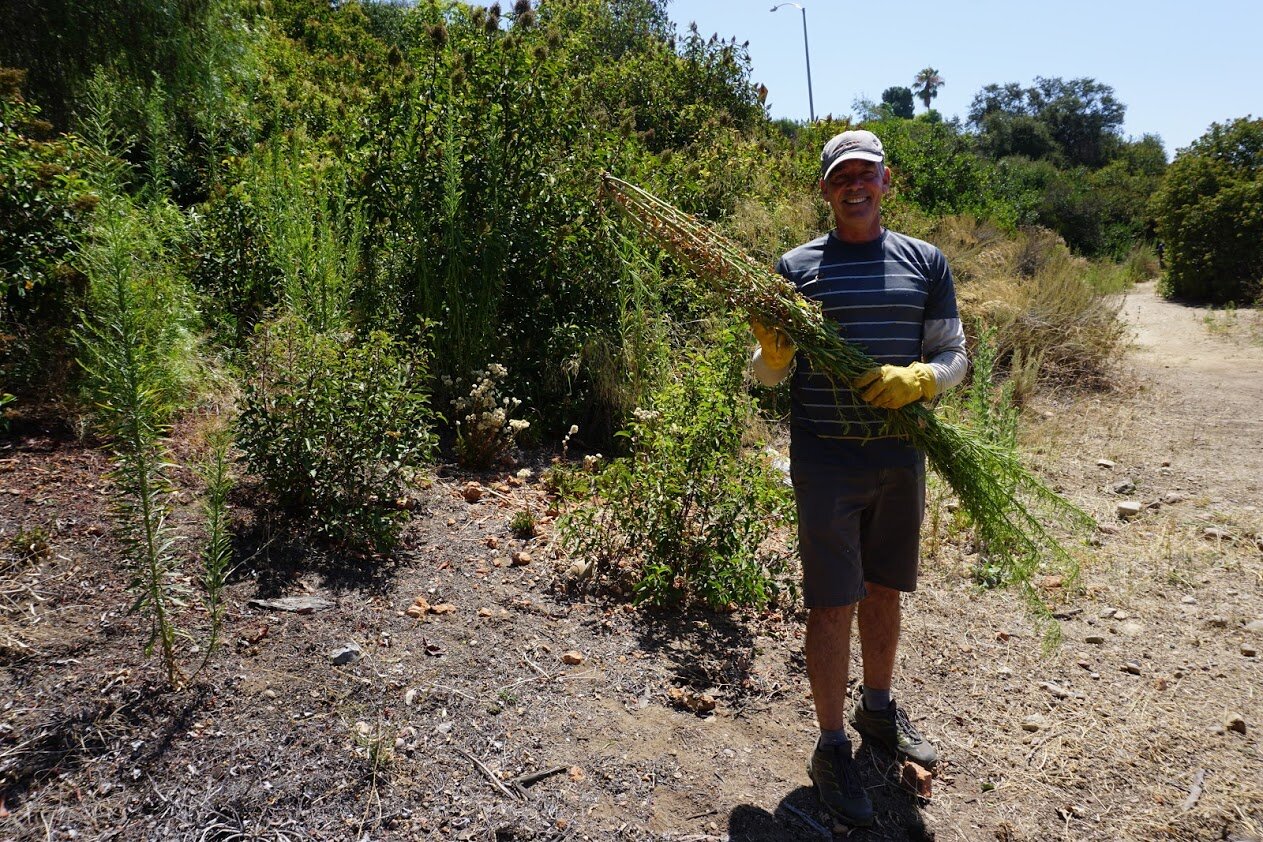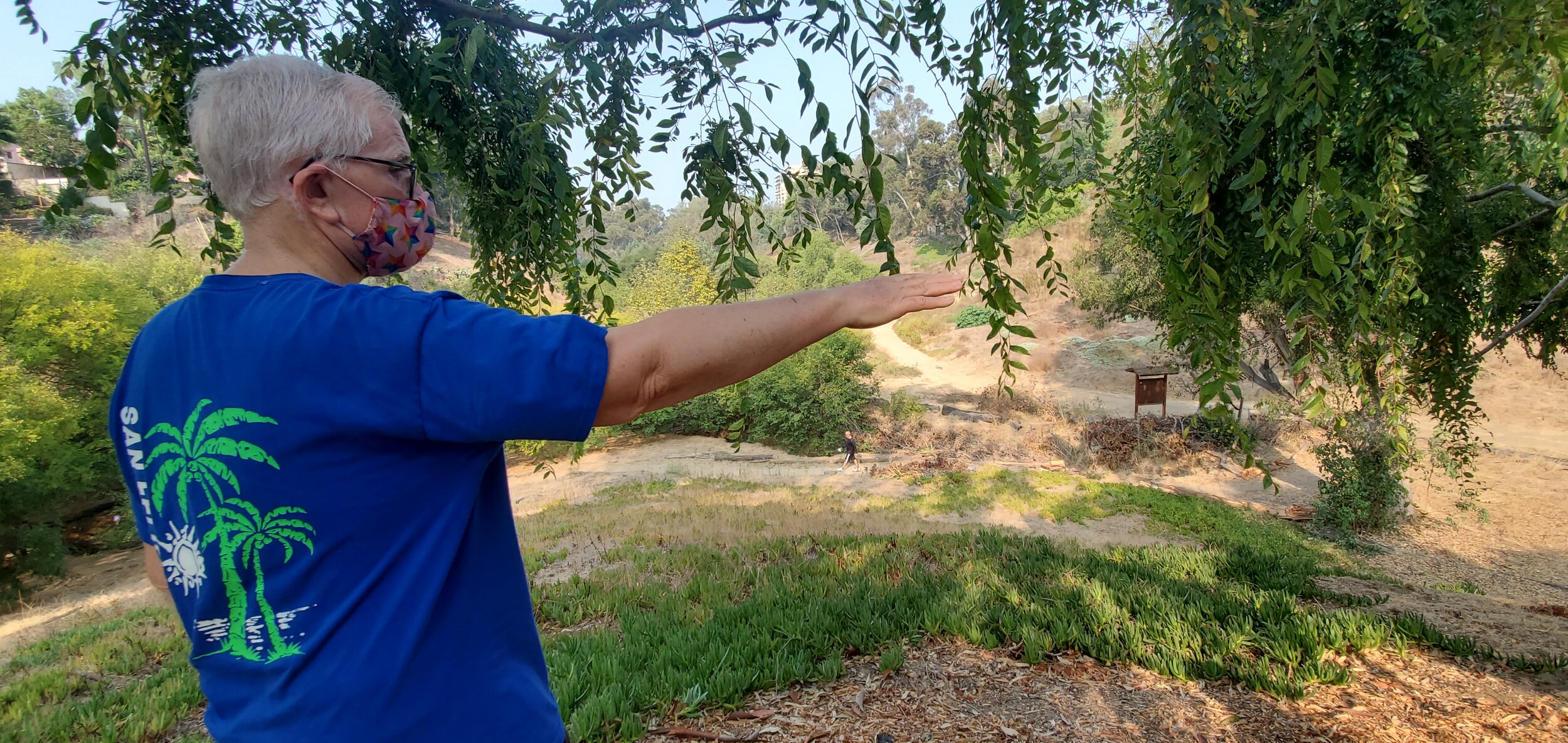Gifts from the Canyons
Written by Debra Turney, San Diego Canyonlands Intern
I began this journey for myself, in order to reconcile my place in the world. As a retired educator, I was searching for renewed meaning and purpose when I enrolled in a Masters degree program in biology/conservation. I felt my path was laid out when I was granted an internship with San Diego Canyonlands, but days later, Covid-19 hit and everything came to a halt. Months into the quarantine I was able to interview Friends Group Leaders over the phone to assess their needs, and finally, after seven months of seclusion, I was granted the opportunity to venture out into the creeks and canyons to meet these awe-inspiring people. This experience allowed me to talk with others about their lives and experiences, and I discovered that my situation was not so different. In these divergent settings consisting of different forms, I discovered that people were engaging with the same questions as I. My life began to expand with each visitation and I realized the canyons and creeks each held a special gift for me, and now I would like to share them with you.
John Hanley, Olivia Canyon Friends Group Leader, removing invasive plants along the trail in the Canyon
The Gift of Community
I visited four canyons within the City Heights Canyons Complex (Olivia/47th St., Swan, Hollywood, and Pepper) with Olivia/47th St. Canyon Friends Group Leader John Hanley. As we walked from one canyon to the next, John shared the bountiful harvest the canyons have to offer. Along the way, we would sometimes step out onto the streets where aromas of dinners cooking in neighboring homes would greet us. I realized that not only do the canyons and creeks connect habitats, they connect communities as well. I had the opportunity to meet George with his new puppy, and he graciously gifted me with a homegrown zucchini. We also stopped to chat with Linda Pennington, in her front yard. Linda is an extremely active member of the Azalea Park neighborhood and the City Heights Community Organizer for San Diego Canyonlands. What an honor it was for me to meet her! John shared the many projects taking place in the canyons. Looking up towards his home overlooking the canyon he affectionately named his neighbors and told of their contributions to the canyons and trails. I left with a sense of expanded community, that our existence does not stop at our driveways, but increases out into the world connecting all life together as one. We have only to take the first step.
Al Mazur, Marston Canyon Friends Group Leader
The Gift of Stewardship
Al Mazur’s home overlooks Marston Canyon. While shepherding the canyon as a Friends Group leader, he also strives to preserve the historical integrity of the area. An architect by trade, Al takes great pride in his historical home which was built in 1933, and is referred to as the Burton-Sessions house. Milton Sessions was the initial landscape designer, who happened to be the nephew of the legendary Kate Sessions, responsible for supplying much of Balboa Park's greenery. As a master gardener himself, Al uses principles of hügelkultur, permaculture, and water catchment in his own yard. In addition to this, Al and his Friends Group volunteers, working with Ranger Carole Rukstelis, tend to the care of Marston Canyon. His dedication to horticulture, history, and his surrounding environment exemplifies the meaning of stewardship. I left understanding the importance of preserving our historical roots by becoming a steward who contributes to and maintains the natural processes of life.
Overlook of Ruffin Canyon
The Gift of Discovery
Upon arrival, a first time visitor could never know of the hidden treasures Ruffin Canyon has to share. Located adjacent to Taft Middle School, the upper path and native garden is well tended. Over the years, the school has used the area for science instruction. It was obvious that Monica Fuentes, one of Ruffin Canyon’s Friends Group leaders, is in love with San Diego’s canyons. She was delighted to share the canyon’s hidden pathways. With her home perched on the bluff above us, we began our descent into the canyon, which was an adventure in itself. I had never seen a lemonade berry bush the size of a large tree! Last December, over 300 palm trees were removed from Ruffin Canyon, a project led by San Diego Canyonlands to reduce the fire risk and restore the natural habitat. Monica describes the event as being one of the most memorable of her life. With the palms removed, fire danger is decreased and native plants have room to grow. The trail along the floor of the Ruffin Canyon follows through the middle of a creek bed, which would make it impassable during the rainy season, but it provided a welcomed, cool oasis on this particular day. We began our trek at 9:30 am, with the temperature around 82 degrees. While we were investigating the canyon floor, unknown to us, the temperature rose by over 15 degrees, so by the time we began our ascent, the temperature was almost 100 degrees. I had heard stories of people dying of heat exhaustion while hiking in a canyon, and I had never understood the phenomenon until now. I was reminded how important it is to always be prepared when hiking. Monica Fuentes, Kevin Johnston (another active leader in the Ruffin Canyon Friends Group), and other members volunteer their time to maintain the beauty and health of this canyon.
John Sanders, a Tierrasanta Canyons Friends Group Leader, tending to a planted oak tree.
The Gift of Ingenuity and Foresight
Friends Group Leaders Maria and James Sanders (pictured above tending to an oak tree the Friends planted) took me on a tour of one of the Tierrasanta Canyons, Shepherd Canyon. This area was once a part of Camp Elliott, a Marine Corps training camp. All of the trails in this area link to Mission Trails. Today, Shepherd Canyon is an example of ingenuity and foresight. At one time this area was covered with palm trees. James mapped the area, noting the location of each tree, and this began the process of removing over one thousand palm trees. This work has reduced the fire hazard and opened the area for native plants and oaks. As the acacia and other invasive plants have been removed, over 200 oak trees have been planted over the last ten years. The trees are on a watering schedule to ensure they receive sufficient water as they take root. James, an engineer by trade, has also designed bridges and water diversions along the pathways. His attention to form and detail has turned this canyon trail into a wonder to behold. Maria and James have developed a supportive network of volunteers. They work closely with Parks and Recreation and also receive an annual donation from the local Kiwanis Club, which they use to maintain their equipment. Further up the trail, there used to be a pond that was frequented by waterfowl and wildlife. Over the years it has filled with silt and is slowly changing into a meadow. While overlooking the area we viewed a coyote chasing after a rabbit. This is a beautiful area to visit. The work that Maria and James with the other members of the Friends of Tierrasanta Canyons have contributed over the years is evident everywhere you look.
Rose Creek flowing under a busy street in Pacific Beach
The Gift of Possibility
The Rose Creek watershed runs approximately 36 miles, passing through Marian Bear Park in San Clemente Canyon. Pictured above is the stark dichotomy between the natural habitat of Rose Creek and the urbanization of a Pacific Beach roadway. Historically, the creek entered Mission Bay at the Kendall Frost Marsh, but it was diverted and channelized during the first half of the twentieth century. This area was once a 4,500-acre tidal marsh, but the results of creating Mission Bay has reduced the wetlands to about 40 acres today, contributing to the loss of 90 percent of California’s wetlands to date. Karin Zirk and Laurie Carlock head the Friends of Rose Creek, and with a handful of volunteers, act as the sole gatekeepers maintaining the creek. During my visit, Karin Zirk kept repeating, “What happens in Rose Creek happens in Mission Bay.” It is so true. The Friends of Rose Creek have taken on the large task to monitor and upkeep this creek habitat where approximately four tons of trash accumulates each year. Zirk has petitioned the City Council for a part-time ranger on several occasions, to no avail. While walking with Laurie Carlock, we spotted an osprey in its nest on top of the Mission Bay High School’s field lights. We also viewed herons, sandpipers, hawks, ducks, rabbits, and mullet fish circling in the water alongside a pair of stingrays. The abundance of wildlife in this “living oasis” is astonishing... and in dire need of care and recognition. The work these women are doing to eradicate invasives and slow the flow of trash can be witnessed everywhere along the trail. It's as if they are on the front lines defending the last stronghold...
Finally, I left with the realization that it is possible to live in harmony with nature, to exist side by side with the natural world. We have only to open our eyes and step out of our front door to experience and appreciate Earth’s wonders…
“Never doubt that a small group of thoughtful, committed citizens can change the world; indeed, it is the only thing that ever has.” -Margaret Mead
Debra Turney, San Diego Canyonlands intern
Debra Turney is a retired educator of thirty years, holding a Masters degree in Education/ESL. She will be graduating in December 2020 with a Masters degree in Biology/Conservation through Miami University and San Diego Zoo Global. Living in North County, Debra is interested in studying the dynamics of the San Diego environs being a “Hot Spot” within the California Floristic Province. She is appreciative of the time she has been able to spend with San Diego Canyonlands.
All photos by Debra Turney and Kindra Hixon







